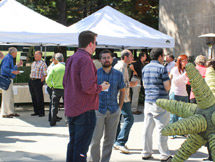
Handy Links
SLAC News Center
SLAC Today
- Subscribe
- Archives: Feb 2006-May 20, 2011
- Archives: May 23, 2011 and later
- Submit Feedback or Story Ideas
- About SLAC Today
SLAC News
Lab News
- Interactions
- Lightsources.org
- ILC NewsLine
- Int'l Science Grid This Week
- Fermilab Today
- Berkeley Lab News
- @brookhaven TODAY
- DOE Pulse
- CERN Courier
- DESY inForm
- US / LHC
SLAC Links
- Emergency
- Safety
- Policy Repository
- Site Entry Form

- Site Maps
- M & O Review
- Computing Status & Calendar
- SLAC Colloquium
- SLACspeak
- SLACspace
- SLAC Logo
- Café Menu
- Flea Market
- Web E-mail
- Marguerite Shuttle
- Discount Commuter Passes
-
Award Reporting Form
- SPIRES
- SciDoc
- Activity Groups
- Library
Stanford
Around the Bay
Past Successes, Future Endeavors Discussed at Fermi/LAT Collaboration Meeting
Today is the final day of the Fermi Gamma-ray Space Telescope–Large Area Telescope Collaboration Meeting, during which over 180 members of the collaboration from all over the U.S. and the world met to celebrate two years of nearly flawless operation. More importantly, they met to ponder their—and the telescope's—future course.
On Monday morning, Persis Drell welcomed everyone to SLAC, first in her role as a member of the collaboration, then in her role as lab director. "It's been a spectacular two years for Fermi," she said. "The performance of the LAT has been a highlight of our science program."
Several speakers that first morning focused on the successes of the LAT, mentioning discovery after discovery, some of them the first of their kind: Pulsars that flash only in gamma rays; high-energy gamma rays from a white dwarf star gone nova; and the LAT collaboration's publication of the 100th paper based on Fermi data.
However, the early success of the LAT could lead to an unintended consequence: a slowing pace of discovery as the brightest, most easily detected gamma-ray sources are detected and thoroughly examined. Stanford professor Peter Michelson, principal investigator of the LAT, outlined necessary steps the team should take to ensure that doesn't happen.
"Fermi is largely driving high-energy astrophysics," Michelson said during his talk, but in order to continue to do so the software for reconstructing and classifying events that trigger the LAT must continue to improve. In other words, the Fermi team must be able to extract more information from the raw data. In addition, Fermi must continue to partner with other groups studying observations taken in other wavelengths in order to gain a more complete understanding of the interesting objects the LAT detects.
As Seth Digel, SLAC physicist and Fermi team member, explained in his presentation, this can only add to the telescope's great strength: data. "After two years of science data, the low-hanging fruit may have been picked," he said, but the ability to gather cleaner, more usable data with improved software and collaborations with other groups can only lead to a deeper understanding of the gamma-ray sources that Fermi detects and the universe in which they're found.
—Lori Ann White
SLAC Today, September 3, 2010
